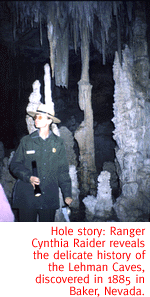
Out There Guy Reaches A New And Glorious Low In Great Basin National Park.
By Kevin Franklin
NOT READY TO face the heat? Does the thermometer lapping
at the edge of the century mark strike terror into your heart?
Fear not, there's a place where the heat miser has no grip--Great
Basin National Park in Nevada. The park's Lehman Caves guarantee
a year-round temperature of 50 degrees, no matter how hot things
get locally. But the Nevada retreat is cool in more ways than
one: The Lehman Caves rank among the most highly decorated caves
in the western United States.
Massive formations called "shields" are their hallmark.
When calcium carbonate-rich water squeezes through fissures in
the walls, it gradually forms a limestone disc. These discs, located
throughout the cave walls, have evolved into formations like "The
Parachute." The crown jewel of the cave, the table-sized
shield hangs high above our heads, with its stalactites draping
down like the cords to a parachute.
 Thousands of other fantastic and whimsical shapes fill the cave.
Porous bulbs resembling giant turnips grow on the ceiling. When
ferreted out with the beam of a flashlight, they give off a caramel-colored
translucence. Soda-straw stalactites blanket whole rooms. Fragile
tubes of limestone, soda straws hang straight down or sometimes
bend in gravity-defying shapes--cave Krazy-Straws, if you will.
Thousands of other fantastic and whimsical shapes fill the cave.
Porous bulbs resembling giant turnips grow on the ceiling. When
ferreted out with the beam of a flashlight, they give off a caramel-colored
translucence. Soda-straw stalactites blanket whole rooms. Fragile
tubes of limestone, soda straws hang straight down or sometimes
bend in gravity-defying shapes--cave Krazy-Straws, if you will.
"Bacon" clings edge-wise to the walls in wavy patterns,
its thin strips of light and dark bestowing the marbled pattern
of its namesake. "Popcorn" similarly adorns the walls.
All this naturally crafted food sculpture is enough to make you
hungry--packing a post-tour lunch might be advisable.
The guided hike wanders along the subterranean passageways for
six-tenths of a mile. At every turn, some new and strange shape
captures the imagination. Unlike Carlsbad Caverns in New Mexico,
or Tucson's own Colossal Cave, you get a real feel for a caving
experience here. The route in some places is tight and narrow,
and occasionally calls for ducking beneath menacing-looking stalactites.
Of course, the cave is by no means in its natural state. A concrete
floor levels the footing, and cleverly ensconced electric lights
allow visitors to see. But these intrusions are relatively subtle.
The National Park Service is doing a reasonable job of trying
to protect the formations; and sealed doors keep the exchange
of outside air to a minimum. Rangers keep an eye on visitors and
explain to them the damage they can cause by merely touching formations.
"We all have oils on our hands," says ranger Cynthia
Raider. "You know that oil and water don't mix; so if you
touch a formation, it will stop growing."
She explains that it's the deposition of dissolved calcium carbonate
from the water the creates the formations. If an oily barrier
is established between the formation and its nurturing water,
growth is no longer possible.
Parts of the two-mile cave system are so delicate, they're sealed
off from visitors and rangers alike.
Rangers who work at the park get a once-in-a-lifetime opportunity
to visit the "Gypsum Cave," where the rare gypsum formations
are so delicate a misplaced breath can break them. Other parts
of the cave are sealed off for safety reasons, like the "Talus
Room." A giant block of limestone is slowly creeping away
from the wall of the cave.
 "It definitely will fall," Raider says. "We don't
know if it will be 100 years from now or tomorrow."
"It definitely will fall," Raider says. "We don't
know if it will be 100 years from now or tomorrow."
So the tour that once was a loop now backtracks. Still, it's
one of the best caves in the West, according to 53-year-old Wayne
Gaylor, who first came to the cave when he was a wee 6 years old.
"We've been in a lot of caves," he says of himself
and his wife, Sue. "This is the most highly decorated we've
ever seen."
Abbsalom Lehman discovered the caves in April of 1885, and began
giving tours to supplement his ranching and farming enterprises.
Considering that the caves have endured more than 100 years of
human visitation, they're in remarkably good condition. A few
stalagmites have been sacrificed along the way, but for the most
part the delicate formations Lehman first discovered with his
candle lantern are still hanging there today.
And it's still 50 degrees.
Getting There
Great Basin National Park is in the middle of nowhere
Nevada, making it all the more ideal for a quiet getaway. The
Visitor's Center is west of Baker, Nevada, on State Route 488.
It's open year-round, as are the caves. Cave admission is $4.
For more information, call (702) 234-733; or write Great
Basin National Park, Baker, NV 89311. The park's website is at
www.nps.gov/grba/.

|





